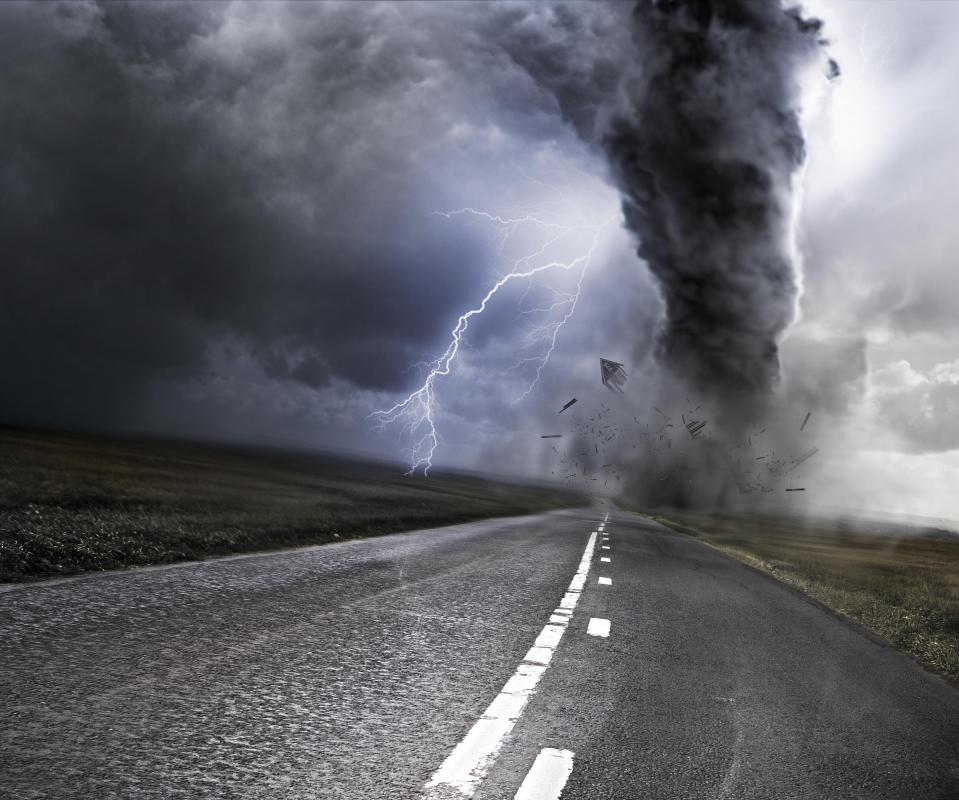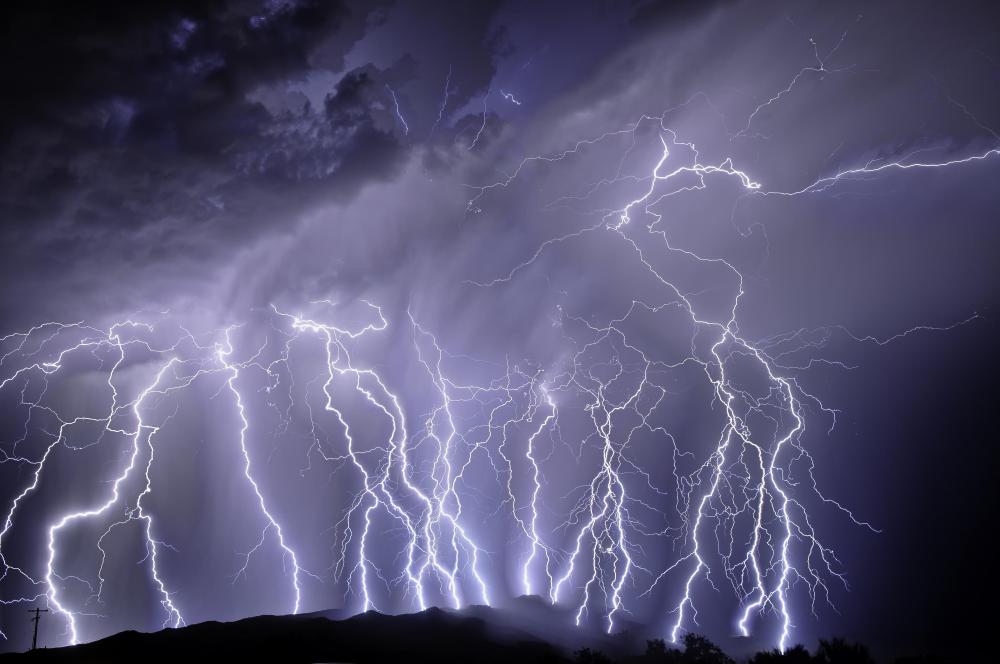At AllThingsNature, we're committed to delivering accurate, trustworthy information. Our expert-authored content is rigorously fact-checked and sourced from credible authorities. Discover how we uphold the highest standards in providing you with reliable knowledge.
What is Hail?
Hail is a frozen form of precipitation generally associated with severe thunderstorms, especially those which form in advance of cold fronts. Large hailstones is also seen as an early indicator of an approaching tornadic storm cell, and they can cause significant damage to exposed structures and vehicles. There are also documented cases where people have been seriously injured or even killed as a result of a heavy hailstorm.
In order for most examples of hail to form, a number of meteorological conditions need to be in place first. Moisture-laden storm clouds must build up to heights approaching 50,000 feet or more. The air temperature at those heights is cold enough to super freeze water droplets, which means they remain liquid in form but below freezing in temperature. If those super frozen droplets made contact with anything solid, called a nuclei in meteorological terms, they would freeze immediately.

The problem is that there aren't too many solid objects floating around at 50,000 feet above the ground naturally. When the winds inside a storm cloud begin to circulate, a powerful updraft is created. This updraft can pull dust particles, insects or tiny ice crystals up to the cloud's highest levels. When these natural nuclei come in contact with the super frozen droplets, they form a small ball of solid ice. Eventually these new ice formations fall towards the ground, but they could be swept back into the top of the cloud formation over and over again by the updrafts. A new layer of frozen water droplets is added to the young hailstone during each trip.

Eventually the ice droplets become too heavy to be supported by the storm's updrafts. The hailstones then fall to the ground like rain or sleet or snow. The size of an individual stone depends on how many times it was drawn back into the upper levels of the storm cloud before it finally fell. If a large piece of hail were cut in half, there would be a number of layers of ice, much like an onion's layers. Stones may be as small as a pea, or under extreme circumstances could become the size of a softball or even grapefruit.

Not all storm clouds produce hail, since the updrafts may not be strong enough to force nuclei materials into the upper levels or the frozen precipitation may melt before it reaches the ground. A tornadic super cell, on the other hand, can have a very powerful updraft capable of picking up dust particles and other nuclei for hailstones. This is why a strong hailstorm is often an indicator that a tornado is approaching or at least about to form.
Frequently Asked Questions
What is hail and how does it form?

Hail is a type of solid precipitation that forms during thunderstorms when updrafts carry raindrops into extremely cold areas of the atmosphere, causing them to freeze. Layers of ice accumulate around the initial frozen core as the hailstone is lifted and dropped within the storm cloud multiple times before falling to the ground.
How large can hailstones get?

Hailstones vary in size, from as small as peas to as large as grapefruits. The largest hailstone on record in the U.S. measured nearly 8 inches in diameter and weighed almost 2 pounds, according to the National Oceanic and Atmospheric Administration (NOAA). However, most hailstones are typically less than 2 inches in diameter.
What factors contribute to the formation of large hailstones?
Large hailstones form in strong thunderstorms with intense updrafts, ample moisture, and a large area of the atmosphere below freezing. These conditions allow hailstones to remain suspended in the cloud for longer periods, growing in size as they collide with supercooled water droplets that freeze upon impact, before gravity finally overcomes the updraft and the hail falls to the ground.
Can hail be predicted?
While predicting the exact occurrence of hail is challenging, meteorologists can forecast the likelihood of hail by identifying atmospheric conditions conducive to severe thunderstorms. Using radar technology, they can detect areas within a storm that may produce hail and issue warnings to potentially affected regions, as per the National Weather Service.
What kind of damage can hail cause?
Hail can cause significant damage to crops, vehicles, buildings, and other property. According to the Insurance Information Institute, hail damage claims in the United States can exceed $1 billion annually. The impact of hail can shatter windows, dent cars, strip vegetation, and compromise the integrity of roofing materials.
Is there any way to protect property from hail damage?
To mitigate hail damage, individuals can use protective coverings for vehicles, install hail-resistant roofing, and use shutters or impact-resistant windows. For agriculture, crop covers and anti-hail netting can reduce damage. Awareness of local weather forecasts and having a plan in place during severe weather advisories is also crucial for protection.
AS FEATURED ON:
AS FEATURED ON:















Discussion Comments
We camp in the mountains every year and aren't surprised when there is a shower every afternoon. One year we were hiking a few miles away and got caught in the rain.
When we returned back to our camp, the whole area was covered with small pieces of hail. Even though we weren't that far away, all we had was rain where the campsite had rain and hail. A few hours later the sun came out and you would have thought nothing strange had ever happened.
Once when we were traveling through the state of Nebraska we could see a big storm coming so we figured it was a good time to pull over and stop for the night.
We were glad we did as there was a lot of hail with the storm and we were glad we weren't trying to drive in it. The next morning as we went on our way you could see where the hail had stripped the corn fields almost bare.
When I think about the amount of loss the farmers had to deal with because of the hail damage it was almost overwhelming.
Last summer the area we live in had a bad hail storm. In just a matter of minutes the hail destroyed hundreds of vehicles and homes.
We live down a dead end road where there are only six houses grouped together. Every one of us had to have our roofs replaced because of the hail damage. Thankfully all of us had insurance to cover the cost of a new roof.
It is amazing how much damage can be done in such a short amount of time. The storm came on very quickly and was over just about as fast, but it didn't take long for the hail to cause a lot of damage.
@wavy58 – Hail doesn't melt as quickly as you might think. For one thing, it usually rains before it hails, and that rain cools off the ground quite a bit. Once the hail arrives, it's falling on much cooler soil.
The smaller and more scattered the hailstones, the quicker they will melt. The bigger, more concentrated hailstones huddle together on the ground and act like an ice pack. They take much longer to melt, even in the summer.
One summer, a horrible hailstorm came to my area. Golf ball sized hail covered the yard.
After it stopped, I went outside, and I could see steam rising everywhere. The hail made the air around it feel cold!
How long does hail remain on the ground after it hits? I know that a lot of places get thunderstorms mostly during the summer, and I would think that the ground would be warm enough to melt the hail rather quickly. Am I right?
My local weather station takes hail reports from people living in the viewing area. They ask people to email their photos of hail from a storm that is in progress, and then they show the photos on the air during the news.
People usually hold the hailstones in their hands for these photos. That gives everyone perspective on just how big they are.
I've seen photos of people holding everything from pea sized hail to golfball sized hail. However, I've never seen a photo of one as big as a grapefruit!
Hail damage repair can be very costly. My dad had parked his truck out in the yard before a big hailstorm hit, and it totally dinged up the hood and the roof.
Luckily, he had insurance that would cover the cost. After that, he built a shed and attached it to the side of the house, and now we all have enough room to park our vehicles under a roof.
@anon264086: According to the Merriam-Webster Dictionary, the word "hail" comes from the Middle English and Old English word, "haegl," which is akin to the Old High German "hagal" and it first came into use before the 12th Century. So it's an old, old, *old* word.
Where did the name hail come from? Who thought up the name hail?
I always wanted to know this information. I live in Northwest Indiana and we had a hailstorm last night.
Thanks.
thanks! very helpful!
thanks. I'm doing my home work right now. i almost failed! thank you, thank you, thank you!
Post your comments